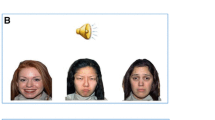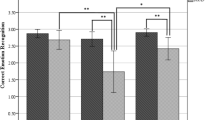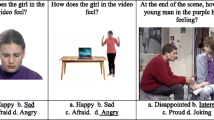Abstract
This study examined the effect of competing auditorily and visually presented word cues on emotion recognition ability in high-functioning adolescents with autism spectrum disorders (ASD). Adolescents with ASD were compared to typical controls on computer-based tasks of emotion recognition. Participants were asked to make a determination about the emotion expressed by a face presented alone, with competing visually-presented word stimuli, and with competing auditorily-presented word stimuli. Individuals with autism were more proficient at recognizing emotions in faces when competing word cues were consistent with the emotion in the face than when they were inconsistent or irrelevant, and all participants were more accurate in emotion recognition when competing word cues were presented auditorily rather than visually, and when competing word cues were consistent as opposed to inconsistent or irrelevant. Contrary to hypothesized results, individuals with autism did as well as controls in making determinations about emotions in faces when competing word cues were inconsistent with the emotion in the faces. Implications of the findings are discussed.
Similar content being viewed by others
Notes
To determine the number of participants needed in each group (n) to detect an effect of a particular size, Cohen’s power tables were consulted (1988). Only one study to date (Grossman et al. 2000) examined the effect hypothesized in the current study. Consequently, the effect size measure d was calculated for comparisons between means obtained in the previous study. Effect sizes (d values) ranged from 1.83 to 2.41 for comparisons between various means. Based on these calculations, a large effect was hypothesized. According to Cohen (1988), to detect an effect (d) of 1.00 using an alpha level of .05 with a power (β) of 80, a group size (n) of 13 would be required for comparison between means. As such, and to increase the likelihood that an effect would be detected, groups in the current study consisted of 17 high-functioning adolescents with autism and 17 controls.
References
American Psychiatric Association. (2000). Diagnostic and statistical manual of mental disorders (4th ed.). Washington: Author.
Attwood, T. (1998). Asperger’s syndrome: A guide for parents and professionals. Philadelphia: Jessica Kingsley.
Baier, B., Kleinschmidt, A., & Muller, N. (2006). Cross-modal processing in early visual and auditory cortices depends on expected statistical relationship of multisensory information. Journal of Neuroscience, 26, 12260–12265.
Baron-Cohen, S., Wheelwright, S., & Joliffee, T. (1997). Is there a “language of the eyes”? Evidence from normal adults and adults with autism or Asperger syndrome. Visual Cognition, 4, 311–331.
Carey, S., & Diamond, R. (1977). From piecemeal to configurational representation of faces. Science, 21, 312–314.
Cohen, J. (1988). Statistical power analysis for the behavioral sciences (2nd ed.). Hillsdale: Erlbaum.
Davies, S., Bishop, D., Manstead, A. S. R., & Tantam, D. (1994). Face perception in children with autism and Asperger syndrome. Journal of Child Psychology and Psychiatry and Allied Disciplines, 35, 1033–1057.
Eisenmajer, R., Prior, M., Leekam, S., Wing, L., Gould, J., Welham, M., et al. (1996). Comparison of clinical symptoms in autism and Asperger’s disorder. Journal of the American Academy of Child and Adolescent Psychiatry, 35, 1523–1531.
Ekman, P. (1976). Pictures of facial affect. Palo Alto: Consulting Psychologists.
Ekman, P. (1984). Expression and the nature of emotion. In K. Scherer & P. Ekman (Eds.), Approaches to emotion (pp. 319–343). Hillsdale: Erlbaum.
Ekman, P. (1993). Pictures of facial affect. Digital Photograph Database. Paul Ekman, Inc.
Gross, T. F. (2004). The perception of four basic emotions in human and nonhuman faces by children with autism and other developmental disabilities. Journal of Abnormal Child Psychology, 32, 469–480.
Grossman, J. B., Klin, A., Carter, A. S., & Volkmar, F. R. (2000). Verbal bias in recognition of facial emotions in children with Asperger syndrome. Journal of Child Psychology and Psychiatry and Allied Disciplines, 41, 369–379.
Jemel, B., Mottron, L., & Dawson, M. (2006). Impaired face processing in autism: fact or artifact? Journal of Autism and Developmental Disorders, 36, 91–106.
Joseph, R. M., & Tanaka, J. (2003). Holistic and part-based face recognition in children with autism. Journal of Child Psychology and Psychiatry, 44, 529–542.
Keith, T. Z. (2001). Wechsler abbreviated scale of intelligence. In The Fourteenth Buros Mental Measurements Yearbook. Online Mental Measurements Yearbook Database.
Klin, A., Jones, W., Schultz, R., Volkmar, F., & Cohen, D. (2002a). Defining and quantifying the social phenotype in autism. American Journal of Psychiatry, 159, 895–908.
Klin, A., Jones, W., Schultz, R., Volkmar, F., & Cohen, D. (2002b). Visual fixation patterns during viewing of naturalistic social situations as predictors of social competence in individuals with autism. Archives of General Psychiatry, 59, 809–816.
Lindskog, C. O. (2001). Wechsler abbreviated scale of intelligence. In The Fourteenth Buros Mental Measurements Yearbook. Online Mental Measurements Yearbook
Lord, C., Rutter, M., & Le Couteur, A. (1994). Autism diagnostic interview-revised: a revised version of a diagnostic interview for caregivers of individuals with possible pervasive developmental disorders. Journal of Autism and Developmental Disorders, 24, 659–685.
Manjiviona, J., & Prior, M. (1995). Comparison of Asperger syndrome and high-functioning autistic children on a test of motor impairment. Journal of Autism and Developmental Disorders, 25, 23–39.
Mann, T., & Walker, P. (2003). Autism and a deficit in broadening the spread of visual.
Miller, J. N., & Ozonoff, S. (2000). The external validity of Asperger disorder: lack of evidence from the domain of neuropsychology. Journal of Abnormal Psychology, 109, 227–238.
Myhr, G. (1998). Autism and other pervasive developmental disorders: Exploring the dimensional view. Canadian Journal of Psychiatry, 43, 589–595.
Ozonoff, S., South, M., & Miller, J. (2000). DSM-IV-defined Asperger syndrome: cognitive, behavioral, and early history differentiation from high-functioning autism. Autism, 4(1), 29–46.
Pelphrey, K. A., Sasson, N. J., Reznick, S., Paul, G., Goldman, B. D., & Piven, J. (2002). Visual scanning of faces in autism. Journal of Autism and Developmental Disorders, 32, 249–261.
Prior, M., Dahlstrom, B., & Squires, T. (1990). Autistic children’s knowledge of thinking and feeling states in other people. Journal of Child Psychology and Psychiatry, 31, 587–601.
Prior, M., Eisenmajer, R., Leekam, S., Wing, L., Gould, J., Ong, B., et al. (1998). Are there subgroups within the autism spectrum?: A cluster analysis of a group of children with autism spectrum disorders. Journal of Child Psychology and Psychiatry, 39, 893–902.
Rojahn, J., Singh, N. V., Singh, S. D., Baker, J., Lawrence, M. A., & Davis, C. M. (2002). Concurrent validity studies of the facial discrimination task. Journal of Child & Family Studies, 11, 203–215.
Schopler, E. (1996). Are autism and Asperger syndrome (AS) different labels or different disabilities? Journal of Autism and Developmental Disorders, 26, 109–110.
Talsma, D., Doty, T., Strowd, R., & Woldorff, M. (2006). Attentional capacity for processing concurrent stimuli is larger across sensory modalities than within a modality. Psychophysiology, 43, 541–549.
Wechsler, D. (1992). Wechsler intelligence scale for children (3rd ed.). San Antonio: The Psychological Corporation.
Wechsler, D. (1997). Wechsler adult intelligence scale (3rd ed.). San Antonio: The Psychological Corporation.
Wechsler, D. (1999). Wechsler abbreviated scales of intelligence. San Antonio: The Psychological Corporation.
Wing, L. (1998). The history of Asperger syndrome. In E. Schopler, G. B. Mesibov, & L. J. Kunce (Eds.), Asperger syndrome or high-functioning autism? (pp. 11–28). New York: Plenum.
Author information
Authors and Affiliations
Corresponding author
Rights and permissions
About this article
Cite this article
Boggs, K.M., Gross, A.M. Cue Salience in Face Processing by High Functioning Individuals with Autism Spectrum Disorders. J Dev Phys Disabil 22, 595–613 (2010). https://doi.org/10.1007/s10882-010-9198-9
Published:
Issue Date:
DOI: https://doi.org/10.1007/s10882-010-9198-9




